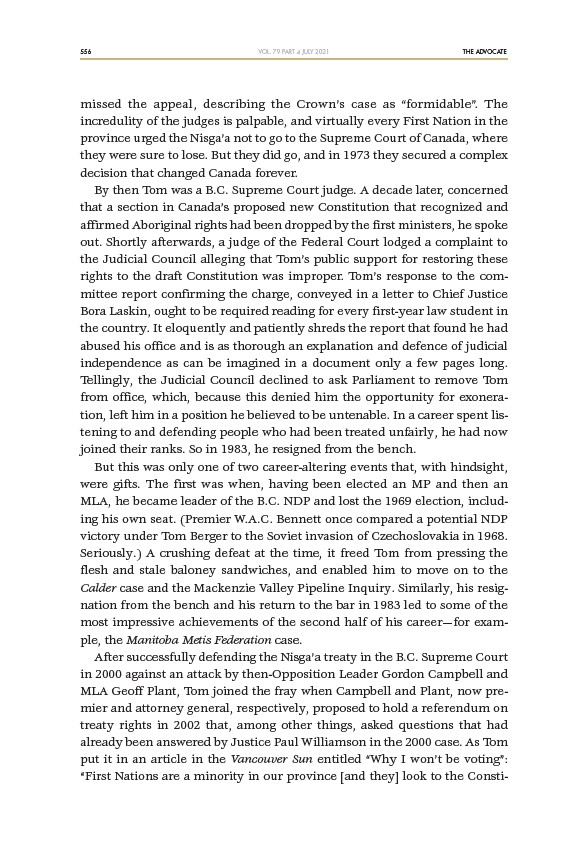
556 THE ADVOCATE
VOL. 79 PART 4 JULY 2021
missed the appeal, describing the Crown’s case as “formidable”. The
incredulity of the judges is palpable, and virtually every First Nation in the
province urged the Nisga’a not to go to the Supreme Court of Canada, where
they were sure to lose. But they did go, and in 1973 they secured a complex
decision that changed Canada forever.
By then Tom was a B.C. Supreme Court judge. A decade later, concerned
that a section in Canada’s proposed new Constitution that recognized and
affirmed Aboriginal rights had been dropped by the first ministers, he spoke
out. Shortly afterwards, a judge of the Federal Court lodged a complaint to
the Judicial Council alleging that Tom’s public support for restoring these
rights to the draft Constitution was improper. Tom’s response to the committee
report confirming the charge, conveyed in a letter to Chief Justice
Bora Laskin, ought to be required reading for every first-year law student in
the country. It eloquently and patiently shreds the report that found he had
abused his office and is as thorough an explanation and defence of judicial
independence as can be imagined in a document only a few pages long.
Tellingly, the Judicial Council declined to ask Parliament to remove Tom
from office, which, because this denied him the opportunity for exoneration,
left him in a position he believed to be untenable. In a career spent listening
to and defending people who had been treated unfairly, he had now
joined their ranks. So in 1983, he resigned from the bench.
But this was only one of two career-altering events that, with hindsight,
were gifts. The first was when, having been elected an MP and then an
MLA, he became leader of the B.C. NDP and lost the 1969 election, including
his own seat. (Premier W.A.C. Bennett once compared a potential NDP
victory under Tom Berger to the Soviet invasion of Czechoslovakia in 1968.
Seriously.) A crushing defeat at the time, it freed Tom from pressing the
flesh and stale baloney sandwiches, and enabled him to move on to the
Calder case and the Mackenzie Valley Pipeline Inquiry. Similarly, his resignation
from the bench and his return to the bar in 1983 led to some of the
most impressive achievements of the second half of his career—for example,
the Manitoba Metis Federation case.
After successfully defending the Nisga’a treaty in the B.C. Supreme Court
in 2000 against an attack by then-Opposition Leader Gordon Campbell and
MLA Geoff Plant, Tom joined the fray when Campbell and Plant, now premier
and attorney general, respectively, proposed to hold a referendum on
treaty rights in 2002 that, among other things, asked questions that had
already been answered by Justice Paul Williamson in the 2000 case. As Tom
put it in an article in the Vancouver Sun entitled “Why I won’t be voting”:
“First Nations are a minority in our province and they look to the Consti-